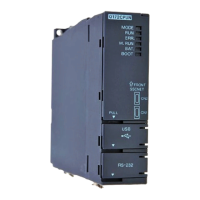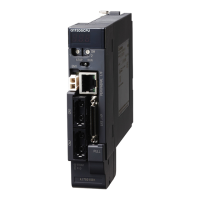1 - 6
1 OVERVIEW
Comparison of Motion control specifications (continued)
Item Q170MSCPU Q170MSCPU-S1 Q170MCPU
ROM operation function Provided
External input signal
Q172DLX, External input signals (FLS/RLS/DOG) of servo
amplifier, Internal I/F (DI), Bit device
Q172DLX or External input signals
(FLS/RLS/DOG) of servo amplifier
High-speed reading function
(Note-6)
Via internal I/F/input module, Via tracking of Q173DPX
Forced stop Motion controller forced stop (EMI connector, system setting), Forced stop terminal of servo amplifier
Number of I/O points
Total 256 points
(Internal I/F (Input 4 points, Output 2 points) + I/O module
+ Intelligent function module)
Total 256 points
(Internal I/F (Input 4 points,
Output 2 points) + I/O module)
Mark detection function Provided
Clock data setting Clock synchronization between Multiple CPU
Security function
Provided
(Protection by software security key or password)
Provided
(Protection by password)
All clear function Provided
Remote operation Remote RUN/STOP, Remote latch clear
Optional data
monitor
function
SSCNET
Up to 3 data/axis (Communication data: Up to 3 points/axis)
SSCNET /H Up to 6 data/axis (Communication data: Up to 6 points/axis) None
Digital oscilloscope function
Motion buffering method
(Real-time waveform can be displayed)
Sampling data: Word 16CH, Bit 16CH
Motion buffering method
(Real-time waveform can be
displayed)
Sampling data: Word 4CH, Bit 8CH
Absolute position system
Made compatible by setting battery to servo amplifier.
(Possible to select the absolute data method or incremental method for each axis)
SSCNET
communication
(Note-8)
Communication
type
SSCNET
/H, SSCNET SSCNET
Number of lines
1 line
(Note-9)
1 line
Driver communication function
(Note-10)
Provided None
Number of
Motion related
modules
Q172DLX 2 modules usable 2 modules usable
Q173DPX
4 modules usable
(Note-11)
3 modules usable
(Note-11)
PLC module which can be control
by Motion CPU (area)
Interrupt module, Input module, Output module,
Input/Output composite module, Analogue input module,
Analogue output module, Analogue input/output module,
High-speed counter module, Positioning module,
Simple Motion module, Control unit of displacement sensor
Interrupt module, Input module,
Output module,
Input/Output composite module,
Analogue input module,
Analogue output module
Number of SSCNET /H head
module connection stations
Up to 4 stations usable Unusable
Number of optical hub unit
connections
Up to 16 units usable Unusable
(Note-1): SV22 virtual mode only.
(Note-2): When the manual pulse generator is used via the Q170MSCPU's internal I/F, the Q173DPX cannot be used.
(Note-3): When the operation cycle is 7.11ms or less, the manual pulse generator I/F built-in CPU can be used.
(Note-4): Any incremental synchronous encoder connected to the Q170MSCPU's internal I/F will automatically be assigned an Axis
No. one integer greater than the number of encoders connected to any Q173DPX modules.
(Note-5): SV22 advanced synchronous control only.
(Note-6): Servo amplifier (MR-J4-
B-RJ) only.
(Note-7): This cannot be used in SV22 advanced synchronous control of Q17MSCPU/Q170MSCPU-S1.
(Note-8): The servo amplifiers for SSCNET cannot be used.
(Note-9): SSCNET
and SSCNET /H cannot be combined within the same line.
(Note-10): Servo amplifier (MR-J3-
B/MR-J4- B) only.
(Note-11): When using the incremental synchronous encoder (while using SV22), you can use the listed number of modules. When
connecting the manual pulse generator, you can use only 1 module.

